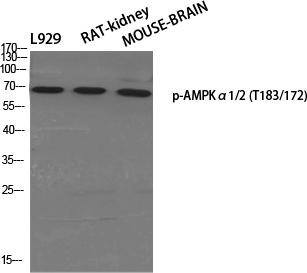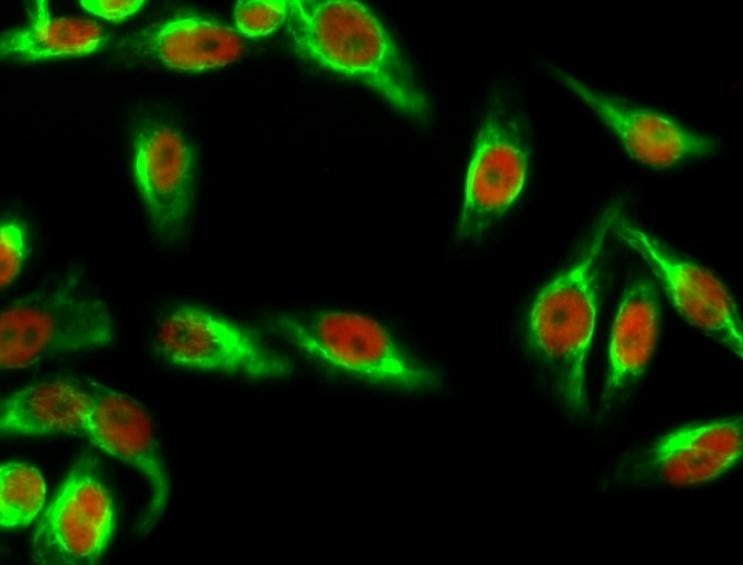购物车
全部删除  您的购物车当前为空
您的购物车当前为空
别名 p-AMPKα1/2 (Thr183/172), p-AMPKα1/2 (T183/172), AMPKα1/2 (p-Thr183/172), AMPKα1/2 (p-T183/172)
Anti-Phospho-AMPKα1/2 (Thr183/172) Polyclonal Antibody 是一种 Rabbit 抗体,靶向 Phospho-AMPKα1/2 (Thr183/172)。Anti-Phospho-AMPKα1/2 (Thr183/172) Polyclonal Antibody 可用于 IF,IHC,WB。
Anti-Phospho-AMPKα1/2 (Thr183/172) Polyclonal Antibody 是一种 Rabbit 抗体,靶向 Phospho-AMPKα1/2 (Thr183/172)。Anti-Phospho-AMPKα1/2 (Thr183/172) Polyclonal Antibody 可用于 IF,IHC,WB。
| 规格 | 价格 | 库存 | 数量 |
|---|---|---|---|
| 50 μL | ¥ 1,490 | 5日内发货 | |
| 100 μL | ¥ 2,230 | 5日内发货 |
| 产品描述 | Anti-Phospho-AMPKα1/2 (Thr183/172) Polyclonal Antibody is a Rabbit antibody targeting Phospho-AMPKα1/2 (Thr183/172). Anti-Phospho-AMPKα1/2 (Thr183/172) Polyclonal Antibody can be used in IF,IHC,WB. |
| 别名 | p-AMPKα1/2 (Thr183/172), p-AMPKα1/2 (T183/172), AMPKα1/2 (p-Thr183/172), AMPKα1/2 (p-T183/172) |
| Ig Type | IgG |
| 交叉反应 | Human,Mouse,Rat |
| 验证活性 | 1. Western Blot analysis of various cells using Phospho-AMPKα1/2 (T183/172) Polyclonal Antibody diluted at 1:500. 2. Immunohistochemical analysis of paraffin-embedded Human breast cancer. Antibody was diluted at 1:100(4°C overnight). High-pressure and temperature Tris-EDTA, pH8.0 was used for antigen retrieval. Negetive contrl (right) obtaned from antibody was pre-absorbed by immunogen peptide. 3. Immunofluorescence analysis of Hela cell. 1,AMPKα1/2 (phospho Thr183/172) Polyclonal Antibody(green) was diluted at 1:200(4°C overnight). (red) was diluted at 1:200(4°C overnight). 2, Goat Anti Rabbit Alexa Fluor 488 was diluted at 1:1000(room temperature, 50min). Goat Anti Mouse Alexa Fluor 594 was diluted at 1:1000(room temperature, 50min).    |
| 应用 | IFIHCWB |
| 推荐剂量 | WB: 1:500-2000; IHC: 1:100-300; IF: 1:50-200 |
| 抗体种类 | Polyclonal |
| 宿主来源 | Rabbit |
| 构建方式 | Polyclonal Antibody |
| 纯化方式 | The antibody was affinity-purified from rabbit antiserum by affinity-chromatography using epitope-specific immunogen. |
| 性状 | Liquid |
| 缓冲液 | Liquid in PBS containing 50% glycerol, 0.5% BSA and 0.02% sodium azide. |
| 研究背景 | Catalytic subunit of AMP-activated protein kinase (AMPK), an energy sensor protein kinase that plays a key role in regulating cellular energy metabolism. In response to reduction of intracellular ATP levels, AMPK activates energy-producing pathways and inhibits energy-consuming processes: inhibits protein, carbohydrate and lipid biosynthesis, as well as cell growth and proliferation. AMPK acts via direct phosphorylation of metabolic enzymes, and by longer-term effects via phosphorylation of transcription regulators. Also acts as a regulator of cellular polarity by remodeling the actin cytoskeleton; probably by indirectly activating myosin. Regulates lipid synthesis by phosphorylating and inactivating lipid metabolic enzymes such as ACACA, ACACB, GYS1, HMGCR and LIPE; regulates fatty acid and cholesterol synthesis by phosphorylating acetyl-CoA carboxylase (ACACA and ACACB) and hormone-sensitive lipase (LIPE) enzymes, respectively. Regulates insulin-signaling and glycolysis by phosphorylating IRS1, PFKFB2 and PFKFB3. AMPK stimulates glucose uptake in muscle by increasing the translocation of the glucose transporter SLC2A4/GLUT4 to the plasma membrane, possibly by mediating phosphorylation of TBC1D4/AS160. Regulates transcription and chromatin structure by phosphorylating transcription regulators involved in energy metabolism such as CRTC2/TORC2, FOXO3, histone H2B, HDAC5, MEF2C, MLXIPL/ChREBP, EP300, HNF4A, p53/TP53, SREBF1, SREBF2 and PPARGC1A. Acts as a key regulator of glucose homeostasis in liver by phosphorylating CRTC2/TORC2, leading to CRTC2/TORC2 sequestration in the cytoplasm. In response to stress, phosphorylates 'Ser-36' of histone H2B (H2BS36ph), leading to promote transcription. Acts as a key regulator of cell growth and proliferation by phosphorylating TSC2, RPTOR and ATG1: in response to nutrient limitation, negatively regulates the mTORC1 complex by phosphorylating RPTOR component of the mTORC1 complex and by phosphorylating and activating TSC2. In response to nutrient limitation, promotes autophagy by phosphorylating and activating ULK1. AMPK also acts as a regulator of circadian rhythm by mediating phosphorylation of CRY1, leading to destabilize it. May regulate the Wnt signaling pathway by phosphorylating CTNNB1, leading to stabilize it. Also has tau-protein kinase activity: in response to amyloid beta A4 protein (APP) exposure, activated by CAMKK2, leading to phosphorylation of MAPT/TAU; however the relevance of such data remains unclear in vivo. Also phosphorylates CFTR, EEF2K, KLC1, NOS3 and SLC12A1. |
| 偶联 | Unconjugated |
| 其他可选修饰符 | Phospho |
| 免疫原 | A synthesized phosphopeptide: human AMPK alpha around the phosphorylation site of Thr172 |
| 抗原种属 | human |
| 分子量 | Actual: 63 kDa. |
| 储存方式 | Store at -20°C or -80°C for 12 months. Avoid repeated freeze-thaw cycles. |
| 运输方式 | Shipping with blue ice. |
评论内容